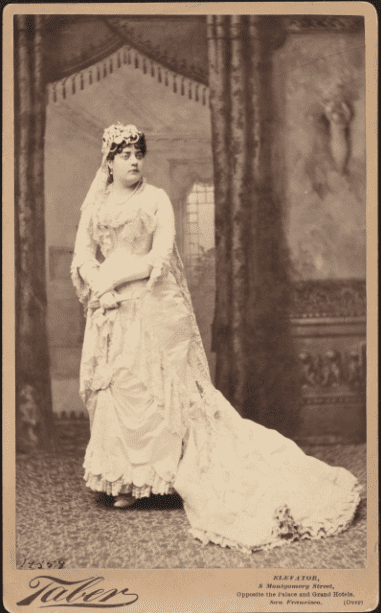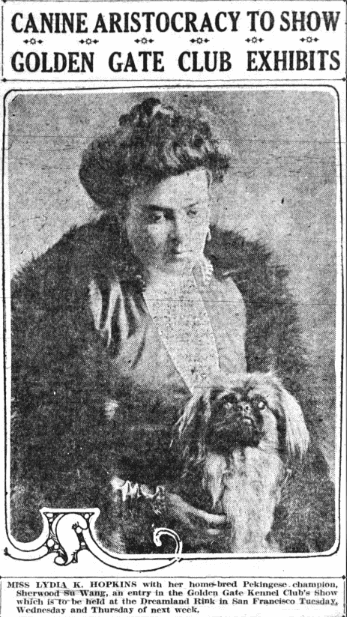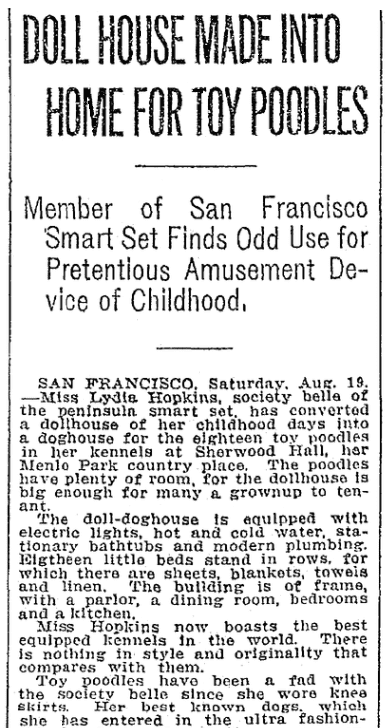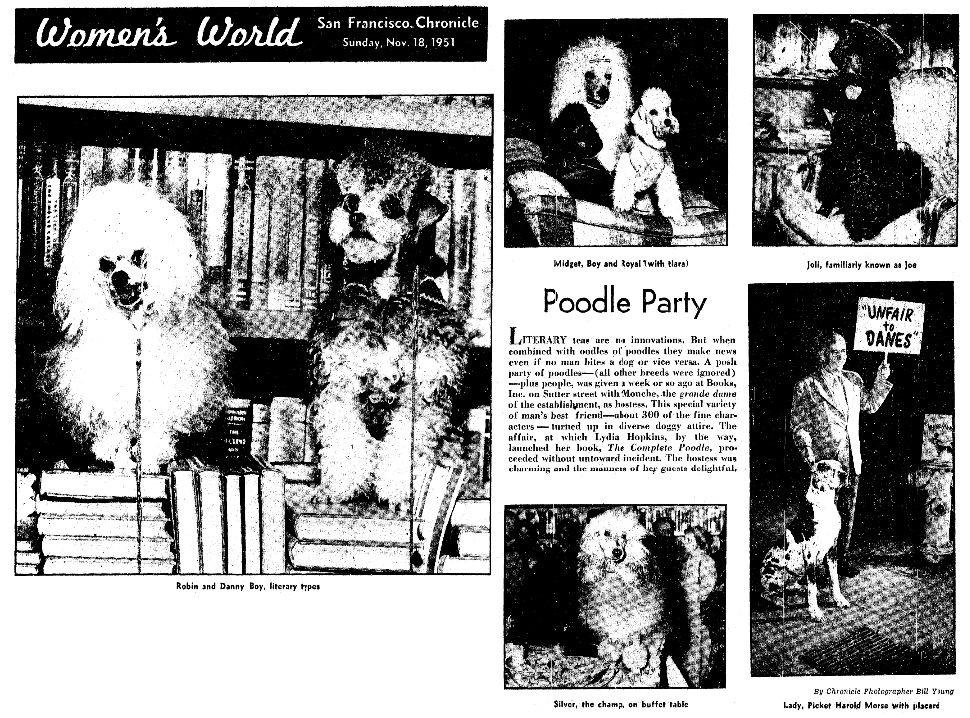Introduction: In this article, Melissa Davenport Berry continues the story of the people affected by the huge fortune left by railroad magnate Mark Hopkins, focusing this time on Lydia Hopkins Melissa is a genealogist who has a website, americana-archives.com, and a Facebook group, New England Family Genealogy and History.
Note: Melissa is writing a series of articles about the people affected by – and the mad scramble for – the huge fortune left behind by Mark Hopkins when he died without a will or heir in 1878. This is the fifth article in that series; links to the first four installments can be found at the end of this article.
The society ladies listed in the early 20th century San Francisco Blue Books descended from potent New England stock. Mary Kellogg Crittenden Hopkins, wife of Timothy Nolan Hopkins, was one of them. Her pedigree earned her memberships into the Mayflower Society, Daughters of the American Revolution (DAR), and Colonial Dames.

The press covered Mary’s social calendar and her charity work.
Mary made no bones that her jewels were just as impressive as her pedigree. Her collection of rare stones included a $40,000 ruby ring. However, when it came to pearls her $100,000 strand matched even the ones of Mrs. John Jay Astor.
A few of Mary’s pieces are at the Metropolitan Museum of Art.
And you are never too young to earn your bling. When Mary’s daughter Lydia Kellogg Hopkins was christened in 1887, godmother Mrs. Leland (Janet) Stanford presented her with a necklace with the letters of her namesake “Lydia” set in diamonds.
It did not take long for the new society belle to assimilate into the San Francisco Peninsula smart set. Lydia became interested in show dogs, and her parents furnished her with the finest breeds money could buy. And yes, their diamond collars were real.

By the age of 16, Lydia had shown over 150 champion dogs. She earned a solid reputation in the dog world. She was the first American invited to the Plaza in New York to judge Pekingese.
In 1911 Lydia converted her childhood dollhouse (big enough for many a grownup) into a doghouse for her 18 poodles.

Each poodle had its own bed fitted with fine linens and blankets. There was a parlor, dining room, and kitchen – all fully equipped with modern plumbing, bathtubs, and electricity.
According to this article:
“Miss Hopkins now boasts the best equipped kennels in the world. There is nothing in style and originality that compares with them.”
The society pages were turning up photos of pretty “bitches,” but not of the human variety. The purebreds that made the news were Lydia’s champs. Many graced the pages of Vanity Fair and Dog Fancy. One pug, “Dark Duchess,” was a celebrated beauty that came with a price tag of $4,000 in 1925. She was very English and required tea and biscuits at 3:00 on the dot every afternoon!
In 1951 Lydia published a book, The Complete Poodle, which was released with a posh party hosted by “Mouche,” the grande dame of the establishment Book, Inc. on Sutter Street in San Francisco.

Three hundred poodles attended the lavish cocktail party. Everything was first class, including the poodle’s masters: Mrs. Gerald Stanford, Mrs. Richard Duff, Mrs. Sanford Lowengart, Mrs. Charlotte Daiber, Mrs. Keneth Brown, Mrs. Albert Ames, and many other socialites.
The lady poodles arrived with sprinkled sequins and ballet skirts, and one of the boy poodles had a cowboy hat and shoulder holster complete with pistol.
The blue ribbons and bowwow treats were presented by Ernest, a butler in full livery. The poodles were provided a designated “fireplug,” with a sign “Messieurs” – however they ignored it, and a black Cadillac was their preferred place to do their business.
Lydia autographed her book for the guests, but there was also an option for a paw print. The book was a hit!
Lydia was the last surviving heir to the Hopkins railroad dynasty, but that did not stop the influx of Hopkins Hopefuls filing in the probate courts to contest the inheritance of her grandfather Mark Hopkins’ vast fortune. It is certain that these gold diggers caught news clips from the society pages. Stay tuned for more on that subject.
Note: Just as an online collection of newspapers, such as GenealogyBank’s Historical Newspaper Archives, told the stories of Mark Hopkins’ fortune, they can tell you stories about your ancestors that can’t be found anywhere else. Come look today and see what you can discover!
Explore over 330 years of newspapers and historical records in GenealogyBank. Discover your family story! Start a 7-Day Free Trial
Genealogy:
- Mary Kellogg Crittenden (1862-1941), daughter of Hiram Crittenden (1814-1883) and Lydia Sherwood (1829-1877).
- Mary married Timothy Nolan Hopkins (1859-1936), who was born to Irish immigrants Patrick Nolan (1829-1862) and Catherine Fallon (1834-1903) in Augusta, Maine. (Harold Clarke Durrell, “Memoirs of Deceased Members of the New England Historic Genealogical Society” NEHG Register April 1936.)
- Timothy was adopted in 1878 by Mary Hopkins (1818-1891), widow of the railroad magnate Mark Hopkins (1813-1878).
- Mary and Timothy had one child, daughter Lydia Kellogg Hopkins (1887-1965).
- Timothy Hopkins was a member of the New England Historic Genealogical Society and produced genealogies. His wife Mary was a member of the Daughters of the American Revolution, the Mayflower Society, and the Colonial Dames. (p. 30, “Order of the descendants of colonial governors Prior to 1750: Roll of Members in State of California.”)
- Mary Crittenden Hopkins was the granddaughter of William Sherwood and Lydia Ann Kellogg, his wife; great granddaughter of Ezra Kellogg and Mary Whiting, his wife; gr.-gr.-granddaughter of Gamaliel Whiting and Ann Gillett, his wife. (Great Barrington Member # 12477 “Lineage Book – National Society of the Daughters of the American Revolution, Volume 13”)
Other Articles in This Series:

So hilarious, good job. Can’t wait for next installment of the madness.
The poodle party… what a hoot.
Thanks Elizabeth! It is quite a party with the Hopkins! I am glad the Mayflower Group is enjoying the drama!
I think that there are many others who care more for their pets than people –- I guess it is that they don’t talk back…
I think you are right on with that Marge! Lydia loved her pooches more that anything! I am trying to track down a photo of the dollhouse! If I do I will be sure to post it! Thanks!
What a great story!!! A house for all her poodles! With their own sheets and linens!!! AND it was 100 years ago!!! Great story!
Thanks Elizabeth! I am glad you enjoyed the story and those poodles lived better than most humans! I wish I was a fly on the wall at the Poodle party!
Such a delightful read! You did a great job while infusing wonderful humor! Enjoyed this very much! Poodles in the doll house — that must have been something! Looking forward to next chapter!!
Thank you CH Burton! I love finding these great tidbits and in the world of Lydia Hopkins pooches did rule! Stay tuned much more Hopkins stories on the way!
Melissa, These are great stories.
Thanks Dorothy! I know any New England lines may tie to you.